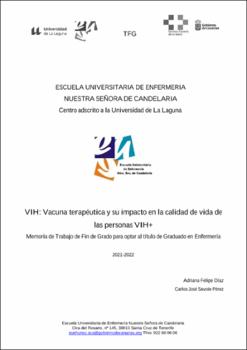VIH: vacuna terapéutica y su impacto en la calidad de vida de las personas VIH+
Author
Felipe Díaz, AdrianaDate
2022Abstract
El Virus de la Inmunodeficiencia Humana (VIH) es una pandemia que sigue estando vigente
entre la población desde la década de los 80 y que, a pesar de los grandes avances de la comunidad
científica, como la creación de la Terapia Antirretroviral de Gran Actividad (TARGA) en 1987, no se
ha logrado obtener una vacuna que elimine el VIH o mantenga un control viral permanente debido
a los desafíos que presenta éste como, por ejemplo, su rápida capacidad de mutación. Es por ello
que, el objetivo principal de esta revisión bibliográfica se centra en demostrara través de diferentes
estudios si existiría una mejora en la calidad de vida de las personas VIH+ ante el desarrollo de una
vacuna terapéutica en comparación con la TARGA. Para ello, se ha realizado una búsqueda en
diferentes bases de datos (Pubmed, BVS y CINAHL) con ayuda de las palabras claves obtenidas
según la terminología “DeCS” y “MeSH”, en la que se reportó una muestra total de artículos de 420;
una vez filtrados los resultados, siguiendo los criterios de inclusión/exclusión, la muestra final fue de
17. Por otro lado, para completar esta revisión con más información, se llevó a cabo una búsqueda
de bibliografía manual en Pubmed,bibliografía inversa y BVS, donde se encontraron 10
publicaciones, por lo que, finalizamos la búsqueda con 27 artículosen total. Los resultados obtenidos
se agruparon en 3 categorías: los desafíos que se plantean a la hora de desarrollar una vacuna,
los estudios llevados a cabo para encontrar una vacuna terapéutica y elementos claves para su
progreso; y, por último, el efecto del TARGA en las personasVIH+ y los beneficios que aportaría esta
vacuna en su calidad de vida.
Como conclusiones principales de la presente revisión de la literatura, se puede observar que la
comunidad científica tiene una idea clara de los principales desafíos para desarrollar una vacuna; que
los estudios y ensayos realizados, dirigidos hacia personas bajo tratamiento, concluyen con un
aumento o recuperación de las células T, aunque, como en el caso del RV405, sólo retrasó el rebote
viral tras interrumpir el tratamiento; y, que, a pesar de que el TARGA proporciona mejoras en la salud
y una mayor longevidad, las personas VIH+ siguen con una preocupación continua a nivel individual,
social, sexual, económico y laboral, impidiéndoles alcanzar una mejora significativa en su calidad de
vida. Finalmente, se llega a la conclusión de que siguen existiendo muy pocos estudios acerca de la
vacuna terapéutica, por lo que es necesario seguir investigando para poder facilitar la vida de las
personas VIH+, de tal forma que puedan mantenerse con una baja carga viral, o indetectable, sin
necesidad del TARGA. The Human Immunodeficiency Virus (HIV) is a pandemic that continues to be present among
the population since the 1980s and that, despite the great advances made by the scientific community,
such asthe creation of Highly Active Antiretroviral Therapy (HAART) in 1987, it has not been possible
to obtain a vaccine that eliminates HIV or maintains permanent viral control due to the challenges that
it presents, suchas it’s rapid mutation capacity. That is why the main objective of this bibliographical
review focuses on demonstrating, through different studies, if there would be an improvement in the
quality of life of HIV+ peoplewith the development of a therapeutic vaccine compared to HAART. To
do this, a search was carried out indifferent databases (Pubmed, VHL and CINAHL) with the help of
the keywords obtained according to the terminology "DeCS" and "MeSH", in which a total sample of
420 articles was reported; once the results werefiltered, following the inclusion/exclusion criteria, the
final sample was 17. On the other hand, to complete this review with more information, a manual
bibliography search was carried out in Pubmed, reverse bibliography and VHL, where 10 publications
were found, so we finished the search with 27 articles in total.The results obtained were grouped into
3 categories: the challenges that arise when developing a vaccine, the studies carried out to find a
therapeutic vaccine and key elements for its progress; and, finally, the effectof HAART on HIV+ people
and the benefits that this vaccine would bring to their quality of life. As main conclusions of this literature review, it can be seen that the scientific community has a clear idea of the main challenges
to develop a vaccine; that the studies and trials carried out, aimed at people under treatment, conclude
with an increase or recovery of T cells, although, as in the case of RV405, it only delayed viral rebound
after stopping treatment; and that, despite the fact that HAART provides improvements in health and
greater longevity, HIV+ people continue to have continuous concern at the individual, social, sexual,
economic and labor levels, preventing them from achieving a significant improvement in their quality
of life .Finally, it is concluded that there are still very few studies on the therapeutic vaccine, so it is
necessary to continue investigating in order to facilitate the lives of HIV+ people, in such a way that
they can maintain a low viral load, or undetectable, without the need for HAART.





